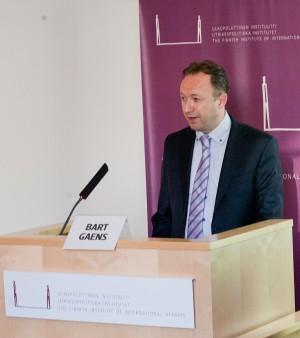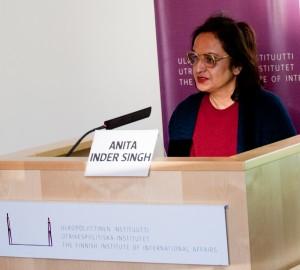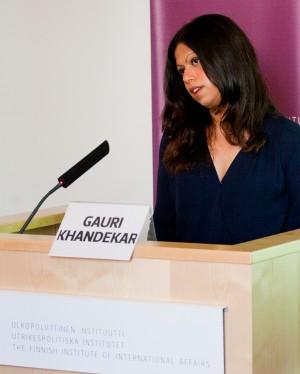Robust economic growth since the early 1990s and an important strategic position have generated images of India as both an economic giant and a key global power. In addition, New Delhi’s ”turn to the East” and increasing involvement in the East Asian regional architecture have led to widely-held views of India as a potential counterweight to China. At present however, the impressive growth of the Indian economy seems to have ended, and strategically the country is caught between close security ties with the US and Asian countries on the one hand, and cautious restraint vis-à-vis China. From a European vantage point, India’s ”strategic partnership” with the EU, in place since 2004, continues to punch below its weight. This seminar assesses the nature and prospects of an enhanced role for India in Asia as well as globally, in the light of China’s rise and the US re-engagement in Asia. Furthermore, the seminar will address the question how the EU’s relations with India can be upgraded to form a mutually-beneficial partnership which both partners can recognize as strategic.
Dr. Teija Tiilikainen, Director of the Finnish Institute of International Affairs opened the seminar on India as an economic power and its role in the world as seen from the EU by welcoming the participants. Dr. Tiilikainen commented that FIIA has hosted many events on Asia and China, and is now finally able to host a seminar on India, one of the strategic players on the global scene and a key emergent power. Thanks to Bart Gaens, FIIA now has this opening and hopes to do more in the future, Dr. Tiilikainen said.
The acting head of Global Security Research Programme Dr. Bart Gaens also welcomed everyone to the seminar examining whether India is a key global power regionally and as a partner for Europe, or not .The picture may look negative Dr. Gaens noted. There is a lot of poverty despite the growth of India’s GDP, the trade talks between the EU and India have broken down, and there has also been a cooling down of political relations with the EU. China’s rise has eclipsed India’s, and China is more important to the EU trade-wise. What could be done to upgrade the EU’s relationship to India and how important India is as a ”global swing state” are issues the speakers will shed light on more, Dr. Gaens said.
Professor Anita Inder Singh, Visiting Professor at the Centre for Peace and Conflict Resolution in New Delhi was pleased to speak about India’s strategic role on her first visit to FIIA. She began her presentation by saying that military power is an important factor in India, which is why China and the US are important actors in Asia, and the EU not as much.
Since 1947 India has seen itself not as a mere military power, but as a country with much to contribute. This self-view might be a bit exaggerated considering geopolitics and Indian resources, Professor Inder Singh said. Other countries would like to see India doing more to halt China’s military growth. The growth rate of Indian GDP since 1981 made it more attractive to many countries in Asia, Europe and the US. India managed to reconcile economic reform with regional nationalism through democracy, which authoritarian regimes such as Yugoslavia and USSR failed to do and collapsed in 1991, Professor Singh stressed. The US has seen democratic India since 1947 as a counter-voice to communist China, and Washington continues to drive and support a larger role for India in Asia, said Professor Singh. There are strategic differences between India and US though. When the US speaks about pivoting to Asia it seems to concentrate on India and East Asia, but to India the view on Asia differs: for India not just east of India is important, but also Afghanistan, Pakistan and West Asia. Afghanistan is more important to India than East Asia, particularly because it is closer to India. US withdrawal from Afghanistan is significant and India sees it as a retreat which will only help Pakistan and China. The third strategic difference between India and US in Asia is that India’s top priority is border disputes with China and Pakistan, both of which want to contest borders with India. China uses an argument that the issue continues because the argument has historical roots, and therefore takes time to settle. It also bothers India that there is a close relationship between China and Pakistan trade-wise, e.g. Chinese arms sales to Pakistan, which is also likely to increase. Economic competition with China e.g. in Afghanistan doesn’t bother India, but rather the border disputes and territorial claims that China makes, both on India and other Asian countries, Professor Singh argued. China’s claims for threatened maritime security also imply that it is not a status quo power but an expanding one, she said. On the one hand there are good trading relations between China and other Asian countries. On the other hand there is expansionist China. And China has done nothing to dispel this impression, that it is a developing expansionist power, which is why India as well as other countries welcome American naval presence in Asia.
Friendly ties between Beijing and New Delhi are essential for stability in South Asia, Professor Singh stressed. China sees Indian government as weak, with too many corruption scandals that have been dropping economic growth, but concludes that India will emerge stronger. China has also noted India devoting time to Sri Lanka, Bangladesh and Myanmar, and India is looking East, cooperating with the US, Japan and Australia. More importantly the Chinese have noted that Indian defence planning focuses on two front wars with China and Pakistan, and that India’s main concern is to avoid land war with China. China will compete for control for some parts of the Indian Ocean, Professor Singh said. US and India are expanding naval power because China is making territorial claims and not just in the Pacific but also on the Indian Ocean area to back up its military power. In her personal view China and India don’t agree very much, said Prof Singh. They agree on state sovereignty and the reform of international organisations, both are members of the BRICS and so on, but otherwise disputes are great between them.
The Sino-Indian economic competition largely occurs in the Indian Ocean, where nearly half of world’s trade passes through. China wants some control and has expanded relations to Pakistan, Afghanistan, Nepal and Sri Lanka, and seeks to use influence in the region. Even if India would fail to overtake China economically, it will remain important economically and militarily in Asia. China only has observational status in the South Asian Organisation for Regional Cooperation (SAARC). If it was to become a full member there would probably be a leadership battle between China and India. Rivalry between India and China is probably inevitable -neither will accept the primacy of the other in Asia, Professor Singh asserted. India will not tolerate China dominating the Indian Ocean or East Asia. India wants to keep out of the dispute between China and Vietnam in the South China Sea and would like to see it solved peacefully. With regard to trade with ASEAN countries, in 2010 India stood at 55 billion, while China was at 350 billion. In the next two years India’s share is expected to rise to 100 billion, but China’s to 500 billion. So the gap between the powers as for trade with ASEAN is pretty big.
With Japan India has no cultural or political conflicts. Annual summits have taken place since 2006 and Japan is also the largest bilateral aid donor to India. There is talk of a strategic alliance in Delhi, but nobody knows what the content of such an alliance could or would be, Professor Singh said. The Japanese Quadrilateral Inititiative of 2007 involving India, Japan, Australia and the US annoyed China. India and the US have both said that this would not be a military alliance and not aimed at China.
Professor Inder Singh concluded her presentation by saying that how large a role India can play in Asia and globally is difficult to predict before the elections in India that will take place in half a year’s time. In the long run everything depends on how much they invest in education and infrastructure, only then can it strengthen its military power and be a key driver of the global economy, and contribute more to international and Asian security. At the moment with the US domestic crisis Americans don’t have sufficient financial clout in Asia. Next year India and US are both domestically preoccupied, possibly opening up opportunities for China, she commented lastly.
Gauri Khandekar’s, Head of Agora Asia-Europe programme at FRIDE (Brussels), presentation centered on EU-India relations. She commented that Finland has reached out and done a lot for the EU India partnership, but Brussels has been taken over by China-EU relations. India’s foreign policy is prudent, embryonic and constricted in nature, driven by self-interest and policy of non-interference, Khandekar described. According to her India has been rewarded hastily as a global power, as there are two Indias: it is still a very poor country with e.g. 400 million people living without access to electricity. India is confident as a regional power but has no ambitions to be a global power. India has no clearly defined sphere of influence, and internal challenges, domestic controversies and corruption affect the functioning of foreign policy. Political parties don’t have a very developed foreign policy and there is a lack of young leaders in India, the average age of leaders being 53 years. Also the colonial history has made India cautious and weary of the West. As a normative power India has been important in building consensus in other Asian countries like Vietnam. Economic interests are a priority for India, Khandekar stressed.
She then went on to speak about the EU- India Strategic Partnership, which has three priority areas: trade, security and energy cooperation. It was signed in 2004, but it is still not functioning adequately. There is limited mutual understanding of each other, and the perspective potential: India looks at EU as a trading partner and the EU expects too much of India in foreign policy. India is a large developing country, something which the EU seems to forget, Khandekar commented. She argued that the Strategic Partnership is far from being it in reality. This year there also was no Summit with the EU. Both the EU and India have security concerns. India sees China’s rise with suspicions. Multilateralism is important for India, and it was disappointed the EU did not support India more to be part of the UN Security Council. India also doesn’t want to be treated as a junior partner. India has conflicting energy policies with those of the EU. There are more bilateral relations with different EU countries, such as Germany and France, than with EU as a whole. India’s growth has diminished, but signing of India would be premature and an error, Khandekar said, using the EU as an example. The Strategic partnership could be strengthened, she said.
It has been estimated that by 2030 India will be the 3rd largest economy in the world, which would amount to more than three times of its GDP now. 1,3 trillion will be needed just for the infrastructure of the growing economy, Khandekar said. India would need to build a city the size of Chicago every year to meet the need for commercial development and healthy urbanization. This should become the cornerstone for the EU-India partnership, she emphasized. In conclusion she noted that the EU-India relationship has lacked the spark of true strategic partners and both have not been able to communicate what their strategist interests are. Trade is important, but to bring the partners to talk to each other is important, she concluded.
Commenting on the two presentations at the seminar was Dr. Olli Ruohomäki, Deputy Director for South Asia, at the Ministry for Foreign Affairs of Finland. He also had observed that India-China relations seem to be especially trade relations, but there is also competition between the two powers. India is concerned about the Chinese investments in the Indian Ocean and India wants to strengthen its ties with the US, Japan and Australia, but not to form a political alliance against China. Indian-ASEAN relations are based on trade and economic growth – but India has also been courted to be an ally against Chinese influence in South East Asia by ASEAN countries. India’s policy in the South East Asian region is not to restrict China but its own economic interests are at the fore. Dr. Ruohomäki agreed with Professor Inder Singh that India still thinks it is best served by its strategic autonomy policy, which is why it doesn’t want any powerful alliances with powerful countries. When it comes to the EU Delhi prefers to deal with individual member states on a bilateral basis. The EU wants to strengthen the political dialogue with India, and to negotiate a partnership and cooperation agreement at some stage. The EU is India’s largest trading partner and investor in India. The EU and India have been negotiating a Free Trade agreement since 2007 – and we would like to see this materialize, said Dr. Ruohomäki.
In the comment section Professor Inder Singh underlined that India sees China as expansionist and that many Asian countries fear Chinese territorial expansion, and in her view China doesn’t seem to be doing anything to lessen these fears. With ASEAN India is only interested in economic ties, and it needs to strengthen itself economically before venturing into any military adventures. In the last few years the GDP growth rate has come down, predicted to be 5 to 8% in the next two years, with 5 % considered too little for India to overcome its problems. India cannot become a superpower unless its economy is in order. That is why India is cautious, and this is wise, she said. She also said that China could learn from Europe that let the territorial disputes go both in 1945 and 1991, and China could do the same. Dr. Khandekar also commented that all countries in Asia have territorial disputes with each other – India and China have long relations. This is just a hiccup, she sees. She also stressed that the EU should view India as a key market. Trade has diminished between EU and India within the last year, while India’s trade with other countries has been growing.
From the audience it was asked if India will become the 3rd largest economy on certain preconditions, with reforms happening, how realistic this expectation is looking at the paralyses of the Indian political system. Professori Inder Singh commented that the government looks weak in Delhi now, but she said not to be hasty and to wait until elections next year. Dr. Khandekar said that business will be key in achieving the GDP goals, and that India will have to change its economic model to an export driven model to get income and growth. She noted it will depend how the next government will tackle corruption and how they will be able to draw investment. Another audience member asked whether India can offer anything to NATO or US for them to stay in Afghanistan. Professor Inder Singh replied that India cannot offer much to US or Pakistan as it doesn’t have the resources to do so. India, not the US – couldn’t halt the Taliban in 2001. Also Pakistan would have objected if India sent troops to Afghanistan. Olli Ruohomäki also commented that stabilising Afghanistan is condition for regional stability, China, Russia and India all have an interest to see a stable Afghanistan. It was also asked whether the lack of trust in EU-India relations are affected by historical background, or EU’s ignoring of India or the fact that Iran is a major supplier of energy to India.



